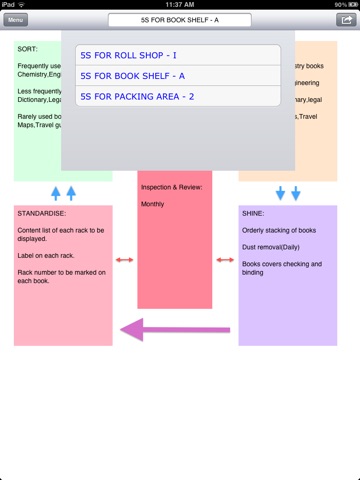
5S was developed by Hiroyuki Hirano of Japan.
5S is the name of a workplace organization method that uses a list of five Japanese words: seiri, seiton, seiso, seiketsu, and shitsuke. Transliterated or translated into English, they all start with the letter "S". The list describes how to organize a work space for efficiency and effectiveness by identifying and storing the items used, maintaining the area and items, and sustaining the new order. The decision-making process usually comes from a dialogue about standardization, which builds understanding among employees of how they should do the work.
The 5 Ss
There are five 5S phases: sorting, straightening, shining(systematic cleaning), standardizing, and sustaining.
Sort (Seiri)
Eliminate all unnecessary tools, parts, and instructions. Go through all tools, materials, and so forth in the plant and work area. Keep only essential items and eliminate what is not required, prioritizing things per requirements and keeping them in easily-accessible places. Everything else is stored or discarded.
Straighten (Seiton)
There should be a place for everything and everything should be in its place. The place for each item should be clearly indicated. Items should be arranged in a manner that promotes efficient work flow, with equipment used most often being the most easily accessible. Workers should not have to bend repetitively to access materials. Each tool, part, supply, or piece of equipment should be kept close to where it will be used – in other words, straightening the flow path. Seiton is one of the features that distinguishes 5S from "standardized cleanup". This phase can also be referred to as Simplifying.[1]
Shine (Seiso)
Clean the workspace and all equipment, and keep it clean, tidy and organized. At the end of each shift, clean the work area and be sure everything is restored to its place. This makes it easy to know what goes where and ensures that everything is where it belongs. Spills, leaks, and other messes also then become a visual signal for equipment or process steps that need attention. A key point is that maintaining cleanliness should be part of the daily work – not an occasional activity initiated when things get too messy.
Standardize (Seiketsu)
Work practices should be consistent and standardized. All work stations for a particular job should be identical. All employees doing the same job should be able to work in any station with the same tools that are in the same location in every station. Everyone should know exactly what his or her responsibilities are for adhering to the first 3 Ss.
Sustain (Shitsuke)
Maintain and review standards. Once the previous 4 Ss have been established, they become the new way to operate. Maintain focus on this new way and do not allow a gradual decline back to the old ways. While thinking about the new way, also be thinking about yet better ways. When an issue arises such as a suggested improvement, a new way of working, a new tool or a new output requirement, review the first 4 Ss and make changes as appropriate.
Range of benefits of 5S:-
1. The elimination of waste in one form or another.
2. Improved productivity.
3. Improved plant maintenance
4. Quality Improvement.
5. Improved Health & Safety.
Hit a text box and start adding action plans/responsibility/observations.Text can be typed into each text box.Background color,Font size and Text color of each text box can be set by accessing settings option(hit menu > settings).
Give a name to new 5S cycle and save it(menu > save).
Note:- This app uses iCloud Storage.
Hit menu > hit New 5S Cycle to add a 5S cycle.Menu>summary provides a detailed summary of the currently active cycle.Menu>cycles list opens the list of cycles for selection.Action button is provided to share the contents of the cycle/ iPad screen.



